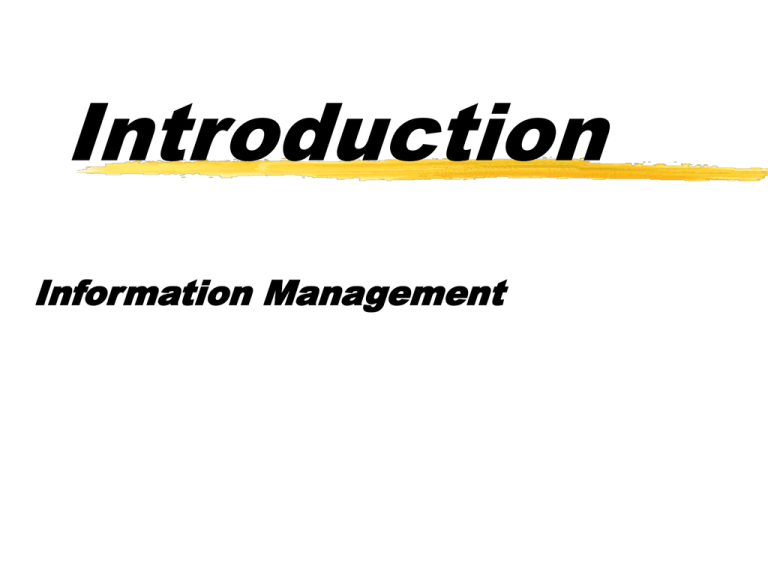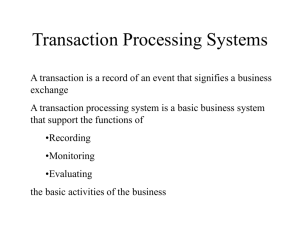Introduction 01/12/00
advertisement

Introduction Information Management Objectives Understand the role of Information Technology and Electronic Commerce in business Be able to specify an information technology product for your company Be literate in the fundamental vocabulary of technology infrastructure Acquire basic personal IT skills What Is Information? Data Raw facts. Computers store data. Information Data in the correct form. Output of an information system. Knowledge Solutions to problems. Information and rules needed to solve specific problems. Wisdom Questions that should be asked. Role of Information in Organizations RESOURCE COMMODITY ASSET What is Information? Business resources are: Land, Labor, Capital. ….Information Replacement for traditional resources Medium of exchange Product Information Adds to knowledge Has surprise value Reduces uncertainty Leads to action Changes a decision Relevant Varies by function and level of management Why Study Information Technology? Moore’s Law: Chip capacity doubles every 18 Months. Next Generation 72% used a computer before they were 10 72% have a PC at home 59% expect to get their news from the Internet by 2000 66% call themselves Intermediate, Expert or Power users The Value of Technology Electric Power Growth Trends The Value of Technology IT Growth Trends Information Systems Concepts 2 IS Productivity Paradox Realizing benefits from IS Integrated Information Systems Interorganizational Information Systems Strategic Information Systems Transformational Information Systems Why the Benefits of IT are Not Achieved Lack of knowledge about IT and IT management Incompatible hardware and software Inefficiencies in work processes Incompatible organizational cultures and climates IT Productivity Paradox IS Productivity Paradox $1 trillion dollars spent on computer and communication technologies since 1980 Systematic relationship to financial performance? People make the difference Four pathways for realizing benefits Definition: Information System a computerized system that processes data and produces information (SSC) a collection of components that collects, processes, stores, retrieves and disseminates information for a specific purpose a computer system designed to accomplish business objectives (IS Primer, Part I) IS Categories Types of Information Systems Cost displacement … Automation systems Improved management … Transaction Processing and Information Reporting Strategic support … Decision Support, Executive Information Systems and Expert Systems Basis of competition … Data Warehousing, e-Business, Strategic Information Systems Components of IS and Definition of System System: A group of parts or components working together to accomplish a goal Components of IS: Data Hardware Software Trained personnel Procedures Managing Information with Information Systems TECHNOLOGY + DATA + PROCEDURES + PEOPLE = INFORMATION SYSTEM Benefits of IS Types Distribution Efficiency Automation Arise from changes in work tasks, procedures and arrangements not just from technology Potential vs. Actual Information Management in the 21st Century Succeeding in a Global Environment The Focus on Quality and Performance Business Process Redesign Building Individual Capabilities and Productivity Time to Market Challenges for Effective Information Management Using Technology Appropriately to Meet Information Needs Dealing with Too Little, Too Much, or Conflicting Information Responding in a Timely Fashion 1 Types of Information Systems Transaction Processing Systems (TPS) Information Reporting Systems (IRS) Decision Support Systems (DSS) Executive Information (Support) Systems (EIS) Expert Systems (ES) Transaction Processing Systems Transaction - Basic business event, act or process TPS backbone of an org’s information systems capture data on “business events” store these data in databases use data to efficiently handle day-to-day business operations provide information needed by law may be complex Transaction Processing Terms Batch processing - transactions are collected as they occur and placed in groups or batches to be processed periodically On-line processing - data are processed as soon as transaction occurs Transaction Processing: Question Which business events? What data should be captured? When should it be captured? Transaction Processing: Guidelines Capture sufficient data Keep accurate Minimize redundancy Keep current Information Reporting Retrieving data stored in databases to produce predefined information reports for managers and other employees Routine reports Structured problems Types of Reporting Periodic Exception Information Reporting: Questions How many reports should be produced? When should reports be received? Who should control the distribution of reports? Information Reporting: Guidelines Keep evaluating the report Highlight important data Include positives and negatives Decision Support Retrieving data stored in databases and then combining these data with analytical rules to create on-demand (often ad hoc, normally interactive) reports to help employees make the decisions they face. Semi-structured problems Sensitivity and goal seeking analysis Decision Support: Functionality Decision structures Access to data (Special database) Analytical tools (Model base) User-friendly interface Decision Support: Questions When should such support be restrictive rather than flexible? Who should define and design these support tools? Decision Support: Guidelines Interface should be consistent with user’s cognitive view of problem A DSS database is established separate from operational databases It may be desirable to restrict user’s actions Executive Information Also called Executive Support Systems (ESS) Geared toward top level managers Provide drill down Have excellent GUI Offer status access Offer access to external databases May include DSS Executive Information: Questions How can use of the system be promoted? Who should use the system? Executive Information: Guidelines Timeliness of information is critical. The system must provide broad, aggregated data with the ability to expand to the detail level. The system must be tailored to the needs of the managers within the specific company. Expert SystemsCharacteristics Artificial Intelligence (AI) application Acts like expert Provides explanations May be rule- or case-based May provide consistent, reproducible second opinion Expert Systems: Components Knowledge rule database Domain database Database management system Knowledge Acquisition/Explanation subsystem GUI Inference engine Expert Systems: Questions How accurate is the information provided by the system? How should the system be used? How can the system be designed to respond to unusual situations? How can the system be updated? How can you give the system common sense? Expert System: Guidelines The key to a good expert system is successful knowledge acquisition from the expert. The information must be timely and complete. Strategic Information Systems Tactics becoming a low-cost producer improving products/services introducing new products/services creating barriers to entry discourage customers from switching to competitors gaining power position over suppliers or customers providing management with higher quality information timely accuracy completeness Such strategic benefits often are not realized. Why not? When they are realized, they are usually short-lived. Why are they so difficult to sustain? What is the basis by which an organization can realize a sustained competitive advantage through its information systems? Strategic Information Systems IS that help gain strategic advantage Significantly change manner in which business supported by the system is done Outwardly aimed at direct competition Inwardly focus on enhancing the competitive position Create strategic alliances Support Activities Primary Activities Firm Infrastructure (general management, accounting, finance, strategic planning) Human Resource Management (recruiting, training, development) Technology Development (R&D< product and process improvement) Procurement (purchasing of raw materials, machines, supplies) Inbound Logistics (raw materials handling and warehousing) Operations (machine assembling, testing) Outbound Logistics (warehousing and distribution of finished product) Marketing and Sales (advertising, promotion, pricing, channel relations) Service (installation, repair, parts) Value Chain Model Chain of basic activities that add to firm’s products or services Primary activities Secondary activities Value Chain Primary Activities Inbound Outbound Operations Marketing and Sales After-Sale Services Value Chain Support Activities Technology development Procurement Human Resources Management Management Control accounting/finance coordination general management central planning Competitive Forces Threat of entry of new competition Bargaining power of suppliers Bargaining power of buyers Threat of substitute products or services Rivalry among existing firms Strategies for Competitive Forces Note - strength of force is determined by factors in industry Gain a competitive edge Build defenses against forces Formulate actions to influence forces Three Generic Strategies Cost leadership (lowest cost in industry) Differentiation of products/services Focus (finding a specialized niche) Be Low Cost Producer IT strategic if it can: Help reduce production costs & clerical work Reduce inventory, accounts receivable, etc. Use facilities and materials better Offer interorganizational efficiencies Produce Unique Product - IT strategic if it can: Offer significant component of product Offer key aspect of value chain Permit product customization to meet customer’s unique needs Provide higher/unique level of customer service/satisfaction Fill Market Niche - IT strategic if it can: Permit identification of special needs of unique target market Spot and respond to unusual trends Strategic Questions Can IT create barriers to entry? (new entrants) Can IT build in switching costs? (buyers) Can IT strengthen customer relationships? (buyers) Strategic Questions (cont) Can IT change the balance of power in supplier relationships? (suppliers) Can IT change the basis of competition? (competitors) Can IT generate new products?(competitors, substitutes) Risks of IS Success Change the Basis of Competition Lower Entry Barriers Promote Litigation or Regulation Awake Sleeping Giant Reflect Bad Timing Are Too Advanced Transformational Information Systems Radical changes in an organization’s business processes Radical changes in an organization’s structure Radical changes in an industry’s value streams Business Process Reengineering (BPR) Completely changes manner in which business is done Fewer steps, shorter cycle times Complete, more expert handling of events Not incremental improvement Typically uses IT as an enabler Involves discontinuous thinking Characteristics of BPR Combining jobs Empowering employees Jobs done simultaneously Customizing product/service Work performed where most logical Single point of customer contact Transformational Information Systems Radical changes in an organization’s structure reduce layers of management empower front-line workers loosely couple work units Radical changes in an industry’s value streams disintermediation creating new markets

